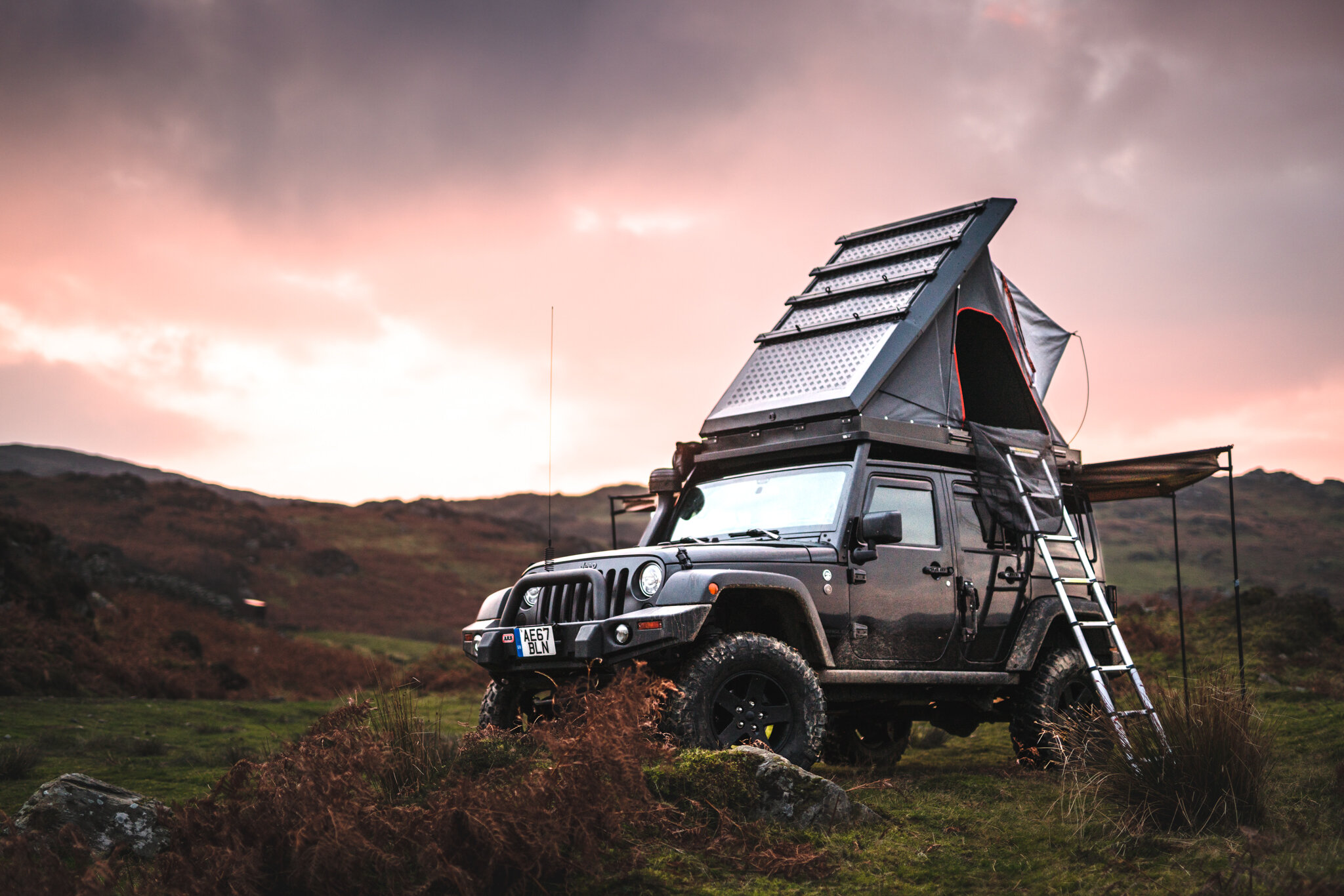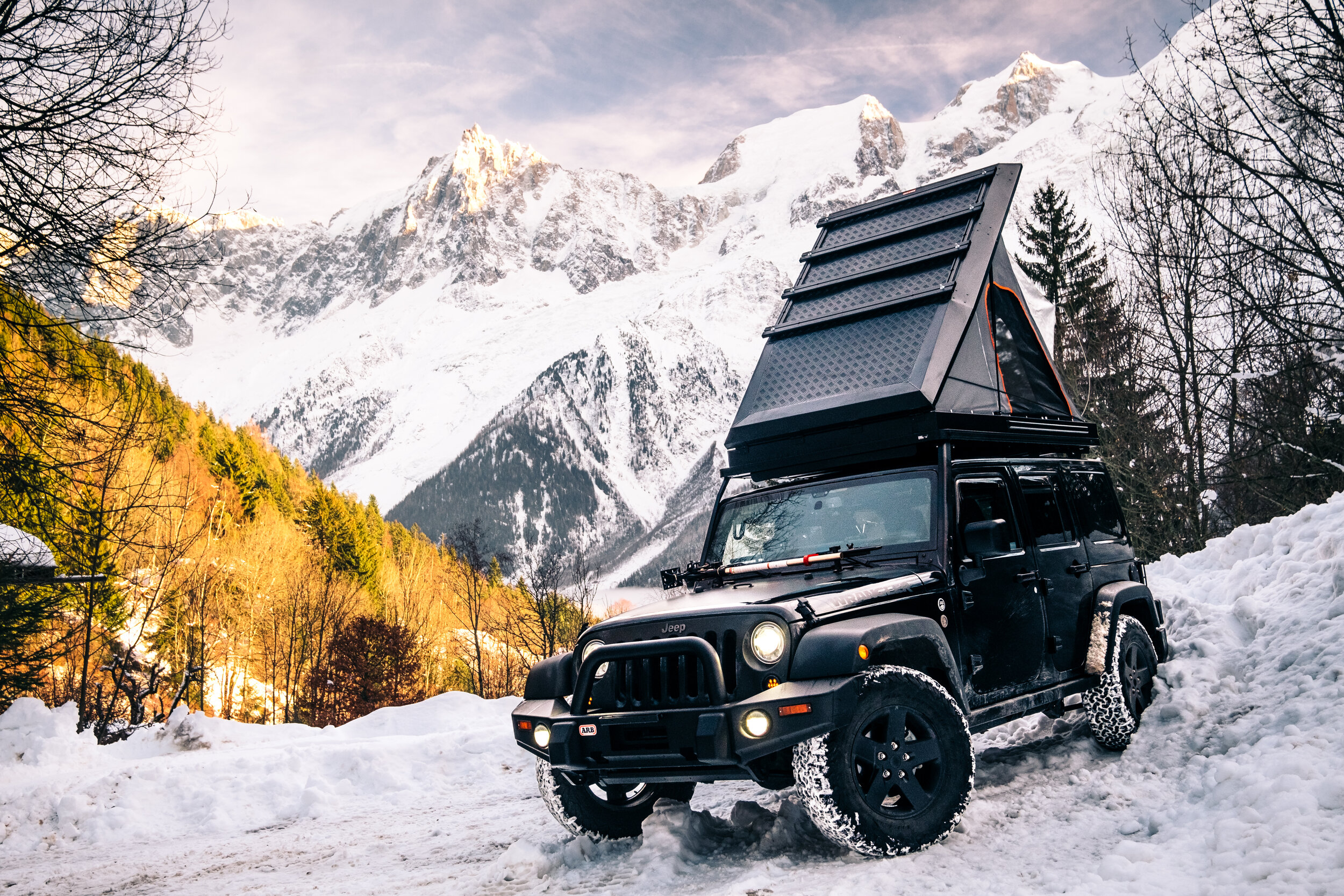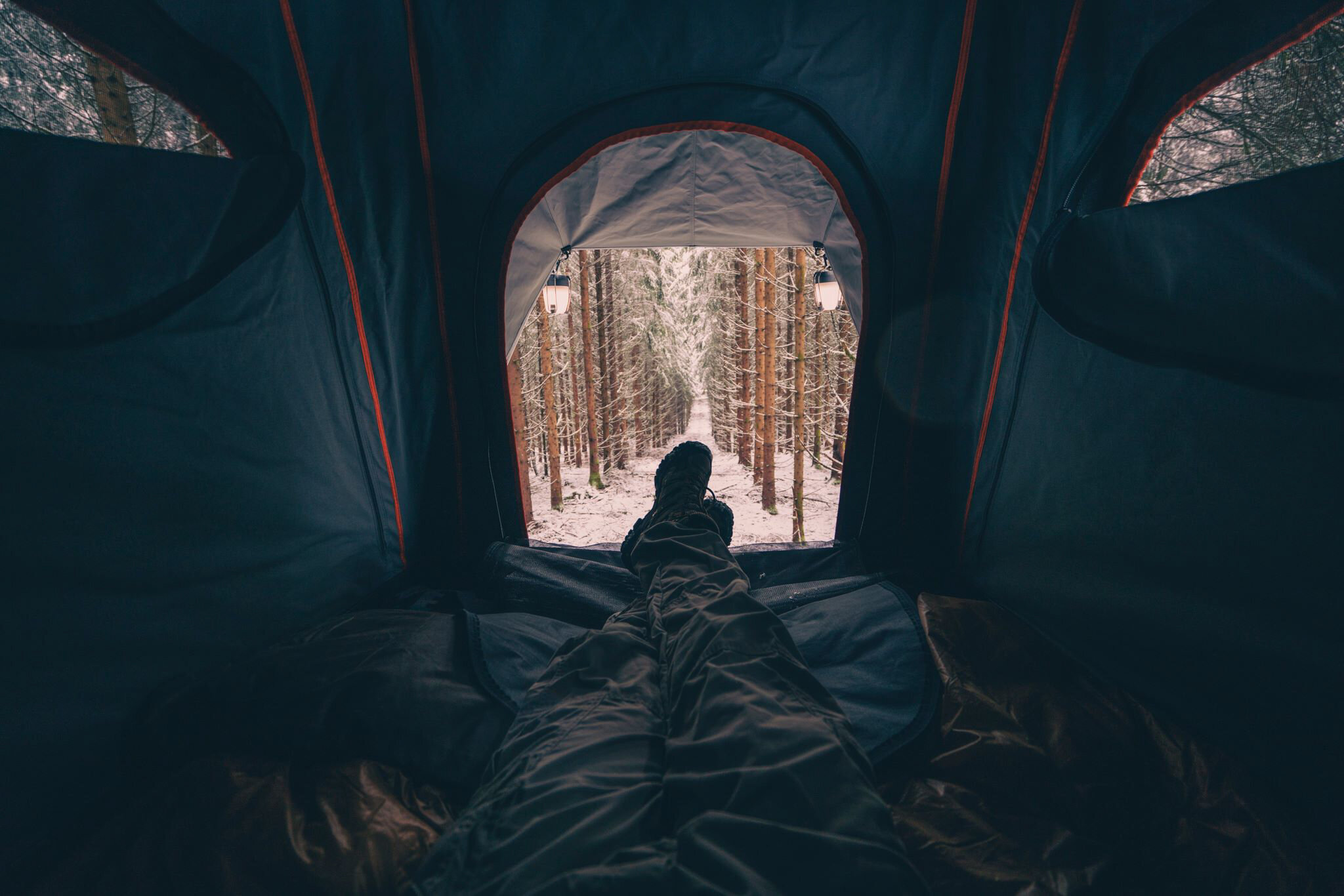My Experience:
I have owned the Expedition III a little over two years and have used the tent for shelter easily over 150 nights during that time. The tent supported me while blazing through the heat in the Bardenas Reales in Spain. It kept me cozy traveling through the French and Italian Alps while snow poured down around me and it has never failed to keep me dry no matter how hard the rain and wind hit me on trips through the Scottish Highlands. The Expedition III is an exceptional tent; there is simply no doubt about that. I do have some notes I need to share for anyone considering the purchase of one.
The Facts:
The Expedition III Roof Top Tent is Alu-Cab’s entry into the hard shell RTT battle. In the case of Alu-Cab, it is the only entry at all for rooftop tents as a whole. The companies other options consist of a full drop-in truck bed camper, truck canopies, or the fabled Icarus, a pop-top roof conversion for the Land Rover Defender. The Alu-Cab stands apart with its rugged look and brutish design due to the utilization of aluminum over fiberglass, a feature few tents on the market can boast about at this time. The tent is also one of a very select few hardshell tents with the ability to place equipment on the roof and still open with the ability to load your crossbars into the built-in tracks or run a proprietary load bar system offered directly from Alu-Cab themselves. The tent comes with a ladder (more on that horrid thing later) and a 75mm high-density foam mattress. I was also initially pleased to find the tent has internal lighting and power hookup utilizing a convenient Anderson power connector. The RTT opens in a traditional “clamshell” fashion with the struts being nicely tucked inside the system when it closes up. I am a big fan of this as it avoids any potential for trail damages if the exterior gets rubbed on a passing tree or cliff. Once the tent is opened up, you will find a respectable, thick canvas. The fabric offers three openings, one on each side, with an additional one to the rear with extra material to position out with poles as a small canopy cover for the entryway. I have noticed Alu-Cab now offers the option for the side openings for an added cost. Closed up and ready for travel the tent is 2300mm or 90.5 inches long and 55 inches or 1400mm wide with its tallest point when eclosed measuring just under a foot tall at 210mm or 11 inches. The tent is no small setup and is not winning any weight watchers competitions either coming in at 88Kg or just shy of 200 pounds. Additionally, the tent comes down on your bank account with a hefty fine of 3800$ or €3790/£3295 respectfully.
Some General Thoughts:
The Aluminum construction of the tent is much appreciated and is still probably the single most significant selling point of the RTT for me. That said it comes at a cost in weight and design. This tents fabricated like a signals box on top of a US Forces HMMW; it is not aerodynamic. Some love the rugged look, the hard lines, and hefty feel, but I grew to dislike its coffin attitude and find Alu-Cabs obsession with diamond plating a bit 90s. Some of the companies funds could go to the design team is all I am saying. However, the rugged build is not without any benefits; I never worried about trail damage to the tent.
Additionally, the “clamshell” flip-up design coupled with the heavy canvas is perfect when pitched up in heavy winds.
Speaking of sleeping like a baby, let me tell you about the tents bed. The critiques are valid; if you like a firm mattress, Alu-Cab has the one for you. The mattress is not by any means terrible, but it's also nothing to write home about, especially if you have slept in the competition. Eezi-Awn or James Baroud effortlessly have the win if I was going to compare comfort. Staying inside you will notice above I mentioned I was initially pleased with the fact the tent offered interior lighting and power. The sad part is that this feature was such an afterthought much like the storage pockets panel quickly sewn to the interior roof. The lights are a weak diffused system located not above but on the floor of the tent. I want to stress some funding again should go to the design and testing department over at Alu-Cab. I would love to meet the poor guy who gave the green light on this idea.
I will hand it to Alu-Cab on the struts. I have loaded Front Runner Jerry cans of fuel and wolf boxes of supplies on the roof and still been able to with minimal effort open the tent. Not only that but do so without any anxiety concerning it staying open. What I will critique, however, is the elastic band designed to such the fabric in when closing. It always sorta just flops it doesn’t do well to retain its elasticity taking to long to regain its “strength.” Finally, I want to talk on how massive the tent as a whole can be. At least for a Jeep owner and most SUV or light truck owners its right on the edge of acceptable. My Front Runner rack takes up the entire top of my Jeep Wrangler, something already relatively uncommon for roof racks of my vehicle due to a design of the hardtop. The tray is only 68mm longer than the tent and a mere 25mm wider. The Alu-Cab is so large I can't even use the side slots as it covers the entirety of the rack side portions. This rack is by no means a small amount of space, and I don’t doubt that most trucks will end up looking like Fotornr’s 4Runner. You know, where the tent is larger than the entire roof space giving off a weird mushroom effect that is not aesthetically pleasing to most eyes. Considering the bottom of the RTT is a hard-line box, it doesn’t help the visual impact or your gas millage for that matter.
The Bad:
Outside of the critiques I already spoke of above the Expedition III is generally an awesome tent. I do have some personal design complaints relating to it’s overall coffin-like exterior and cave-like interior however.
Alu-Cab could quickly fix these issues. The addition of a condensation pad under the mattress, some vents, and a fan similar to what other RTT's like the James Baroud offer would be a good start. I think allowing more of the heavy canvas to be zipped away in good weather is a good idea. Doing so would enable the Expedition III to feel less like a dank cave and more like a penthouse on top of your rig. Additionally, it would also help to vent the tent when returning home after rainy camps.
Fix how the tent mounts. Do ten minutes of research and realize how most roof racks are constructed and ship the tent ready to easily attach to your K9, Rhino-Rack, and Front Runner style platforms. Welding two long channels under the tent is just poor design. This way of affixing the setup only contributes to the overall “lazy and dated” feeling, something I don’t expect when needing to sell a kidney to afford this setup. Also, toss that god awful thing you guys are calling a ladder. Ship it with the telescopic one from amazon that everyone is going to buy anyway. Front Runner sees fit to charge a buck fifty for coloring it black, so I'm sure you can find your way to profit from this change. Trust me; customers will thank you. The current one is a hassle to use, is fixed length and feels again cheaply put together in a rush to check a box, like an afterthought.
I also think the windows should roll up instead of down; it is just a bit awkward to have all the potentially wet material laying over your mattress.
Fit a new mattress sourced from the same folks your competition goes to and handle the elastic band becoming worn exceptionally quickly. With Alu-Cab, the issues are all due to a lack of listening to the end-user during the design phase or small quality control problems. The entire product as a whole has a general feeling of being unchallenged and untested, this is something I will touch on a bit more in my final notes though.
The Good:
One of the best features of the Alu-Cab is that I can load so much onto the roof. I mean look at that image above, not many companies will be able to show off their tent running a full roof load. I may have grown not to utilize the feature as much as I once believed, but who cares. I realized later I had fallen for the marketing before actually testing it and found that in practicality, it's just a pain to get stuff from up there. However, if you need to load up some bikes for a quick trip or run the Kayak on the roof with this tent that capability is not lost by merely having a roof tent. With how much of a pain it is to remove a 200-pound metal tent I am happy Alu-Cab planned for folks fitting and leaving the RTT. Even if you don’t plan on loading the roof up, the ability to easily mount things to the top is excellent. This feature makes for the installation of solar panels or recovery equipment for long term mounting very easy.
The tent, despite its cave-like nature, has handled a wide variety of weather conditions and temperatures. When I wanted a mid-day nap on the hot beaches in Spain, I found the RTT comfortable only needing to open all the windows for some ventilation. I slept comfortably in the tent in cold enough temperatures to freeze my boots to the mattress by the time I woke for sunrise in the Alps. The Alu-Cab is adaptable to most climates with the right equipment.
A general plus side to hardshell tents is their rapid deployability, but I still have to mention this. It isn’t just numbers or convenience, think about how much of the stress in camping is setting up, nearly all of it right? Everyone enjoys having a nice cold beer by the river in the mountains after an awesome day on the trails, but no one enjoys the work to get to that bliss. I never worry about having time to make camp with this tent on the roof. I know I can go hours into the darkness of night if need be due to camp setup being a simple thirty second or less process. I undue two clips at the rear of the tent, I toss my pillow in, and because the tent allows me to have enough room to store my blankets inside, I head off to bed. I don’t even need to set up a ladder if it's late I opt for climbing up the spare tire and into the tent from there.
Final Thoughts:
Overall the Expedition III is excellent, easily one of, if not the best hardshell tents on the market right now. It is clear the person who engineered the tent spent some time camping in their days but as I said above the design team needs the same experience. So many of the small issues and problems with this tent could be solved with minimal R&D, field testing by folks who use and abuse the product, and more investment into the design. This tent comes with a platinum pricepoint. Sadly, I honestly believe Alu-Cab has taken to the belief that if you're the best the market has to offer there is no reason to innovate. I get the feeling this tent ticked the boxes enough to be sent out the door when I use it. I don't feel Alu-Cab is pushing the limits to make something that will change the game. With what they are asking from my wallet, they need to do better in my opinion.
Just because you are the best doesn’t mean your worth your weight. I think the competition will catch up to Alu-Cab quickly and if they do not start improving and innovating, then they will be left in the dust. The rising market in North America means more competition. Companies like Go Fast Campers, James Baroud, and IKamper are already out competing Alu-Cab today in the RTT market, in my opinion. I believe a few things on this tent were slapped on last-second and as cheaply as possible to add a feature justifying the price point or were simply a total afterthought. Look at how long it took for the canopies over the side openings in the tent to be offered even at extra cost or that infamous ladder for starters. I highly recommend this tent to anyone who can justify that 3800$ price point. I, someone who spends over a month at a time wild camping out of my truck can’t warrant it, however. I don’t know who really can outside of the guys wheeling solely for the gram. I would pay between 2000$ and 2500$ for this setup but not the extra 1300$ they want on top of that. Sort out the issues it has with an update to quality control and a newer version rendering this one obsolete addressing the problems above. I could consider paying what I would for a James Baroud/Eezi-Awn after that. Alu-Cab if you end up reading this review and want to chat on the Expedition IV, I would love to talk. With the number of folks buying this system anyway I figure there is not much motivation for that talk at the moment. I mean at the end of the day I paid full price at one point, right? My final verdict is that this rooftop tent is overpriced, at least for most people. I will take my hard-earned money elsewhere until either the price is low enough or the product is good enough.












